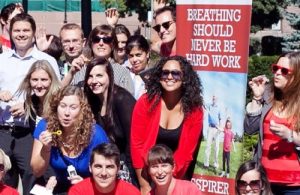Study gives researchers a first overview of PF in Canada

A recent study of 1,285 patients, older than 18, who enrolled in the Canadian Registry for Pulmonary Fibrosis (CARE-PF) during its first 18months (January 2016 to July 2017), provides researchers with a broad overview of the characteristics of the disease in Canada. You can read the full study “Baseline characteristics and comorbidities in the CAnadian REgistry for Pulmonary Fibrosis,” published in the journal BMC Pulmonary Medicine in November 2019.
CARE-PF is the largest registry of ILD patients in Canada and among the largest internationally, with the goal of providing valuable insight into the characteristics, management, and outcomes of these relatively rare diseases. The aim of this particular study was to describe the baseline characteristics, risk factors, and comorbidities (other medical conditions) of patients enrolled in CARE-PF during the first 18 months of patient recruitment.
“It’s important to have a good starting point of basic information about the patient population from the beginning of the registry, before we explore in more detail patients’ experiences and track changes over time,” says Principal Investigator Dr. Jolene Fisher of University Health Network and a member of CPFF’s Medical Advisory Board.
At the time of the study, CARE-PF included patients from six, specialized ILD clinics: two at UBC and one each at University of Calgary, McMaster University, University of Toronto and University of Montreal. CARE-PF has since expanded to eight centres in five provinces, encompassing over 3,500 patients. CARE-PF is funded by Boehringer Ingelheim.
Patients completed study questionnaires and clinical measurements were recorded at enrollment and at each follow-up visit. Environmental exposures were reported by the patients and other medical conditions were collected using an assessment tool called the Charlson Comorbidity Index (CCI).
“We found that more than 20 per cent of patients had what we call unclassifiable ILD, even after being assessed at an expert ILD centre,” says Dr. Fisher. “This was a surprise to me. It means that after all of the usual testing and a discussion involving several ILD doctors, the cause or type of pulmonary fibrosis couldn’t be determined. It’s frustrating for patients and physicians when we can’t determine the type of fibrosis with all of the usual testing.”
Other notable findings are that comorbidities (other medical conditions) and exposures are very common among all types of pulmonary fibrosis, adds Dr. Fisher.
The following are some of the other study results:
Types of ILD
- One third of the patients’ ILD was associated with connective tissue disease (CTD ILD)
- Almost 25 per cent had idiopathic pulmonary fibrosis (IPF)
- More than 20 per cent had unclassifiable ILD
- Slightly more than seven per cent had chronic hypersensitivity pneumonitis (HP)
- Just over three per cent had sarcoidosis
- Three percent had non-IPF idiopathic interstitial pneumonias (including idiopathic nonspecific interstitial pneumonia (NSIP)
- Another six per cent had other ILDs
- CTD-ILD, IPF, and unclassifiable ILD made up 80% of ILD diagnoses at ILD referral centers in Canada.
Other medical conditions (Comorbidities)
- More than a quarter of patients reported having gastroesophageal reflux disease (GERD)
- About 23 per cent had chronic obstructive pulmonary disease (COPD)
- Just over 15 per cent had diabetes
- Almost 15 per cent had obstructive sleep apnea (OSA)
- GERD was most frequently reported by people with CTD-ILD. COPD and diabetes were most frequently reported in those with non-IPF IIPs. OSA was most frequently reported by people with unclassifiable ILD.
Environmental exposures
- Many studies have suggested links between various environmental exposures and different types of ILD. There are strong links for diseases such as chronic hypersensitivity pneumonitis (HP), asbestosis, and silicosis.
- While direct causal links are difficult to establish, exposures such as cigarette smoke, metal dusts, and farming have been frequently associated with IPF.
- Organic exposures were more frequently reported than inorganic ones, including by 50 percent of those with IPF.
- One-quarter of IPF patients also reported an inorganic exposure.
Overall, this research provides a general overview of pulmonary fibrosis patients in Canada, providing the backbone for future CARE-PF research studies. There are currently 20 such studies underway.
“The finding that more than 20 percent of patients had unclassifiable ILD, highlights the fact that pulmonary fibrosis is a challenging and complicated disease and more research is desperately needed,” says Dr. Fisher.
“Ultimately the goal of this research, and CARE-PF in general, is to obtain very detailed data, which has previously not been available, on pulmonary fibrosis patients in Canada. “And while there are almost endless opportunities for research, the overarching aim is to improve the lives of people living with pulmonary fibrosis.”
CPFF will continue to keep you informed of CARE-PF research study results on its website and in this newsletter.
Planning equals impact during PF Awareness Month

It’s never too early to start planning for Pulmonary Fibrosis Awareness Month in September. This year, we’re reaching out to you now to find out what you need from CPFF to make the most of your fundraising and awareness efforts for PF Awareness Month 2020.
Some of the initiatives this year will be familiar, like the Bubble campaign, The Clarke Walk, patient education forums, the lighting of landmarks and town and city proclamations of September as Pulmonary Fibrosis Awareness Month.
There are also a few new things in the works: A Six-minute Walk Challenge (based on the six-minute walk test taken by people with PF) to raise funds and a national media campaign.
We’re hoping to recruit and train CPFF Ambassadors in every province to share their stories with community groups and the media, especially during September. (Read the third article in this newsletter to see if you could be an Ambassador.)
We’ll be putting together a toolkit of digital templates and samples (most done in MS WORD) that you can easily adapt for local events and campaigns in your community. We intend to include the following:
- A Guide to Pulmonary Fibrosis Awareness Month 2020
- A media release template that you can send out to your local media outlets telling them about the national campaign. You can customize it to highlight local events, local spokespeople and local contacts.
- A fact sheet with key messages and stats that you can share with your local media.
- A sample proclamation that you can submit to your local or provincial government to make a request to declare September as Pulmonary Fibrosis Awareness Month.
- A sample 8×11 poster that you can customize to promote a local event.
- Electronic versions of the CPFF logo.
We’re interested in knowing if there is anything else you might find useful in your efforts to increase public awareness and raise funds during PF Awareness Month. Please contact CPFF Executive Director Sharon Lee at [email protected] with any suggestions for PF Awareness Month 2020.
Could you be a CPFF Ambassador?

Are you committed to improving life for people living with pulmonary fibrosis? Do you live with the disease or are you related to someone who does? Do you want to learn how to tell your story effectively to the media, elected officials and groups about PF? Then consider becoming a CPFF Ambassador.
Nothing is more effective at increasing awareness of pulmonary fibrosis than hearing about it from someone who is directly affected by the disease. Your first-hand account, often with photos and/or video footage makes a compelling addition to an article in a newspaper or online, or a broadcast on TV or radio. It draws the readers and viewers that media outlets want and need.
When CPFF makes its case to elected officials and public servants, having a person living with PF and/or a caregiver or other family member share their story, makes them listen and take note, especially if you are also a constituent. Your voice is authentic and true and cannot be ignored. Sharing your challenges and concerns can affect policy change for the benefit of others in your situation.
If CPFF is asked to make a presentation to a service organization like a Rotary Club or a community group, whether for funding support or awareness, a person with the disease is most effective at explaining the impact it has on people’s lives. Your perspective can also be beneficial to medical students or gatherings of other health care professionals.
As CPFF gears up for Pulmonary Fibrosis Awareness Month in September, we’re looking for individuals to make a commitment to become a CPFF Ambassador. If you have the disease, it would be best if your care partner can become an Ambassador too, serving as a backup if your health prevents you from making an appearance. Media training will be provided by CPFF, and you’ll regularly be kept informed of the Foundation’s objectives and key messages and when you can expect to be called upon.
We’ll be looking for men and women from across the country, since a local voice is often requested by media outlets and is essential in government advocacy campaigns. The time commitment is flexible, but you should be available (not on vacation) during September.
If you want to find out more, please connect with Sharon Lee at [email protected].
Sometimes ‘who you know’ does make a difference

Personal connections have likely made a big difference in your life and in your career. A friend introduced you to your future spouse. A former colleague told you about a job opening. Your personal connections can make an even wider difference in the not-for-profit world, improving the lives of others.
CPFF is asking you to consider your own personal connections, especially any in the corporate world, that the Foundation may approach for sponsorship of events, funding of local support groups and education initiatives, or support for PF research.
“We know that people give to people,” says Sharon Lee, CPFF’s Executive Director, who has decades of fundraising experience. “We need to reach out to our community and ask for support from our family, friends and colleagues. In this case, we are asking them to support a cause that is important to us – improving the lives of Canadians living with pulmonary fibrosis and seeking a cure for the disease.”
You may be a member of a union or professional association that funds various health charities. Or perhaps you have a relative working for a corporation that supports charities recommended by employees. Or your best friend runs a small business that also supports community initiatives. Or maybe you know an individual who is an active philanthropist or is involved with a grant-giving foundation.
Ms. Lee would be pleased to either help you approach possible local sponsors or she can reach out directly to your contacts that may be interested in CPFF’s provincial or national campaigns. With national Pulmonary Fibrosis Awareness Month just six months away in September, now is the prefect time to be connecting with potential supporters.
“We have a number of ways to recognize local, regional and national sponsors, especially during September,” says Lee, “from logos on t-shirts, event signs, advertising sponsorship, media outreach and social media campaigns.”
You, or your possible sponsorship contacts, should email Sharon Lee at [email protected] for more information and/or a unique sponsorship package.
Tell your respirologist about our research grants

The deadline for CPFF’s 2020-2021 research grants is fast approaching. Applications for the two, $20,000 research grants are due by noon on April 3, 2020.
Your specialist’s clinic probably employs several qualified individuals, usually respirologists, who may be interested in these opportunities for funding. Let the staff know that they can find the applications and more information in the Research section of the CPFF website at www.cpff.ca. They can also inform their colleagues of these opportunities.
To date, CPFF has invested more than $1 million in 31 research projects and fellowships, thanks to the contributions of numerous sponsors and donors. This is a significant accomplishment for an organization that was established in 2009.
CPFF’s Medical Advisory Board (MAB), established in 2017, examines grant requests received from the research community and determines the recipients. They perform this service for CPFF as volunteers. This group is comprised of eight of Canada’s most highly respected respirologists, pulmonary fibrosis specialists and researchers and helps ensure your donations for research are allocated wisely.
 Update: COVID-19 Message to PF Community
Update: COVID-19 Message to PF Community
For many of us, this is an unprecedented, unpredictable time. The uncertainty all of us face right now is a challenge unlike anything most of us have seen before.
We will get through this time together. We will learn lessons. We will adapt. We will keep marching forward for the pulmonary fibrosis community.
I am always amazed by the resiliency and compassion of our PF community. There have been
wonderful conversations taking place on the CPFF Facebook page, where our community members are offering advice and support to one another on everything from how to navigate personal healthcare needs to finding fresh produce. It is heartening to see so many people being kind and thoughtful to their neighbours, by checking up on them to see how they can help.
CPFF will continue to curate and post useful information about COVID 19 when it’s appropriate. We ask that you monitor the fluid situation through the link below:
https://www.canada.ca/en/public-health/services/diseases/2019-novel-coronavirus-infection.html
These are difficult and challenging times. Please follow the direction of our public health experts. They are doing their best to help slow the spread of this disease and keep our communities safe.
For the time being, please direct all of your COVID-19 questions to your public health agency (phone numbers on the CPFF website) or refer to the above website.
For now, all CPFF patient face-to-face support group meetings are cancelled until further notice. Many of you will have shared contact information with your support group members. Call or email one another for support or just to keep in touch. You are not alone.
For those who would like the option of conducting a virtual support group meeting, please contact Sharon Lee at [email protected]
To help limit the spread of the virus, many doctors are offering phone calls instead of in-person appointments. Some of you may need to be seen and/or have breathing tests for medication funding purposes. In these cases, call your doctor (most likely you will have received a call from their office) to discuss options for your appointment.
If you have any signs of illness – new cough, sore throat, fever, anything – self-isolate and contact your doctor.
I encourage you to reach out to your family and friends and one another by phone, email or Facebook and Twitter. Share your tips on coping while staying at home. You do not have to face this difficult time alone. We are all in this together.
Sharon Lee, MA, CFRE
Executive Director
Canadian Pulmonary Fibrosis Foundation (CPFF)
Below are some suggestions that you may find helpful to maintain social distancing.
Groceries
There are many grocery chains that offer the option of home delivery or onsite pick up so that you can stay out of the stores and the crowds.
Go online and google your grocer to see if they offer this service. You then pick the location closest to you, chose your items and then chose a pick-up time. They will have your groceries ready for you by letting you know which spot to park in. Then they will come out with your groceries and put them into your trunk or back seat.
Banking
All banks have online and regular phone systems so you can do most of your banking remotely. Contact your local bank branch to find out how.


